Feature Interview with Josh Smith
April, 2007
Joshua CF Smith, age 30 years, has worked on almost twenty golf courses, most while under construction. He grew up loving golf and playing at a high level near Portland, OR. He graduated with a business degree from St. Marys College in California, then decided he wanted to be involved somehow with golf course design. He worked as a golf course construction superintendent for six years after graduaton. Since then he has pitched in to help restore the Meadow Club with Mike DeVries and the San Francisco Golf Club with Jim Urbina/Tom Doak. More recently Josh has exercised his passion for golf though his golf landscape oil paintings. Within only a few years of beginning painting, his stature has grown quickly. His work is available at Bandon Dunes, San Francisco Golf Club, Pebble Beach and directly through his website www.joshuasmithart.com . He currently works as an assistant greenskeeper at The California Golf Club (MacKenzie re-design in 1927) and lives above the pro shop where he oil paints evenings and weekends.
1. How did you begin painting golf landscapes?
I think the drive came from loving golf and wanting somehow to be a part of it, creatively. I was always the ‘second best’ artist growing up in class. My mom is pretty artistic and I know I learned a lot about drawing and appreciating the random beauty in nature from her.
More specifically, while building golf courses as a construction superintendent with Wadsworth at Seven Canyons in Sedona, AZ, I found myself in the unusual position of having both weekend days off. All of my friends and family were thousands of miles west of me and it occurred to me to pick up a beginner set of oil paints to fill the spare time. I got really into it right away, waking up at 7am on weekends and pretty much painting all day with Bruce Springsteen playing in the background. I would break to go jogging and eat meals.
Within two weeks of beginning, I was so proud of a painting of the then under construction Weiskopf course, Seven Canyons, I took two paintings in and placed them on the walls during one of our construction meetings with Tom Weiskopf and all the owners. I was pretty nervous in doing this and can remember having real butterflies in my stomach that morning. But when Tom said, ‘You Did This?!!’ it was a pretty good feeling. Looking back, those paintings were pretty standard looking and they are currently collecting dust in the garage.
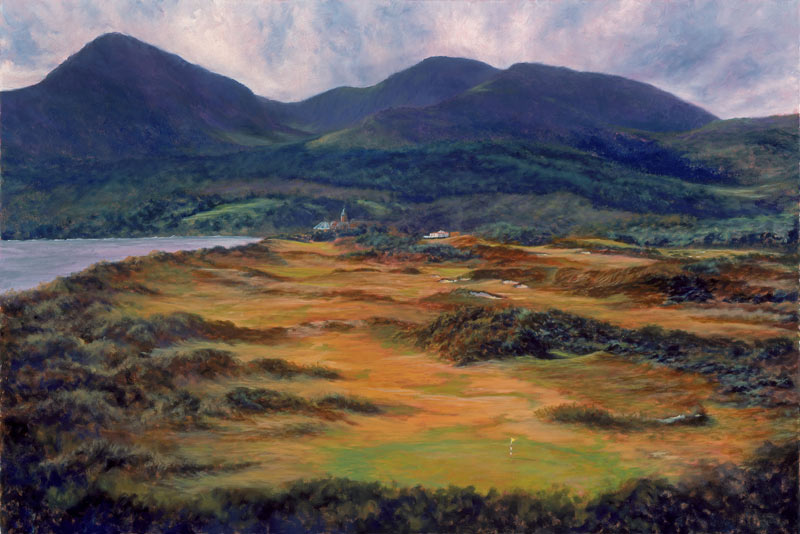
A recent painting of Royal County Down as seen from behind the third green.
2. How many golf courses have you worked on in construction or maintenance?
Last count was 17 or so, not because I couldn’t hold a job, but due to project length. The most exciting have been helping restore Meadow Club, San Francisco Golf Club, and now where I currently work as an assistant superintendent at the California Golf Club.
3. How has your career path evolved?
If you step back and view it as a whole, my ‘career’ does seem to have some structure, however it hasn’t really felt that way. Financially it hasn’t exactly had an upward trend and more than once someone has looked at me and said ‘what the blank are you doing, you have a college degree?’ Luckily, it wasn’t ever anyone in my family or very close to me. And inside I have always thought these events were happening to me for a reason. It kind of reminds me of a Bruce Springsteen song I heard last week where one of the lines goes something like, ‘how fine a line it is between courage and desperation’.
An addiction to golf started gaining momentum around the seventh grade for me. My dad golfed about once or twice a year, but he made a point get us lessons and to teach us the game. He cut off some adult clubs and secured the tops of the leather grips with electrical tape. We would play as a family at the 9 hole muni during summertime. At home, I used to do laps around his house hitting full shots to made up holes of all pars. I made my own limited flight balls. One crunched up ball of tinfoil, wrapped with a lot of saran wrap, and taped, masking tape is best because it isn’t overly heavy. Lots of practice paid off and by the second half of high school I was playing pretty well. My ‘glory days’ story is having the same scoring average as cross town rival Ben Crane junior year. I played on a small scholarship at St. Mary’s College in California and had one very good tournament. Not having any idea what I wanted to do for a living I studied Business and minored in Psychology. After seeing collegiate Paul Casey win the Pac 10 championship in person that year, it became pretty apparent I didn’t have any shot at playing golf for any kind of income. I went to one on campus interview and was not called back. About that time, my dad suggested he had recently met a guy who works for a golf designer and how that seemed like a job he thought I might enjoy.
A week after graduation I was in a drainage ditch helping install drainage pipe on a new course in Northern California. My salary was pretty impressive compared to my friends first jobs and my job description quickly got more important. Working 6 days a week was standard and my Spanish was coming back rapidly. I was an assistant construction superintendent. A year later I was promoted into a superintendents position. The days the designer would show up were the days I jumped out of bed really excited to get to work. I always figured after two years of this, then it would be time to find a way to work with an actual design firm. I ended up staying 5.5 years due to uncertainty of the next move and the fact that I was earning a pretty decent salary.
After a while, I was pretty fed up with the short notice travel and what I felt was a lack of appreciation, building courses with the company I was with. There was a slowdown in work and I was faced with a dilemma, go down to LA and run a backhoe to dig drainage or take a few months off unpaid. This came completely out of left field for me, it was a issue that I didn’t see coming. Neither option was alright with me, so I left the company. I’d had enough and I decided I would take the next couple of weeks until after Christmas to figure out the next step.
The next day, pretty frustrated and confused I got out my oil paints and began painting. I spent a couple of weeks just painting Pacific Dunes paintings and was really enjoying it. I decided it would be a smart move to send out emails to people in industries that I thought I liked and whom I had great respect for in an effort to glean advice. I sent four emails, two of those to people I had never met. One was to Tom Doak whom I had not met. In the email I asked advice, explained my frustration with my previous job, my passion for natural golf design and construction, and attached a couple of photos of my oil paintings.
Within a day Tom Doak had responded to my email saying he did not know much about golf art but that he would like to buy one or two of the Pacific Dunes originals that I had attached. He also said, if I could wait a couple of months, I was welcome to help out with some upcoming bunker restoration at the San Francisco Golf Club. This was such a beacon of hope for me. I knew enough to know how discerning, opinionated and well versed Tom was in everything golf and really took some encouragement from this email. Not to mention I would actually be able to be on the grounds at SFGC and would not be cited for trespassing.
The next two months my daily schedule was wake up real early, get some exercise, grab a bagel and coffee to go, and begin painting. I would microwave a pizza for lunch and pretty much paint all day. In that time I must have finished 6 more Pacific Dunes originals and every two weeks I would email Tom the newest paintings to get his opinion. He continued to seem impressed and expressed interest in the new ones as well. He may have just been being nice, but either way, it was what I needed to hear.
4. What holes have you seen recently that you would really like to paint? Why?
There are a handful of perspectives that I have seen recently that I would love to paint at the following courses, but to simplify, I will narrow it down to one at each. Cypress Point 8. Bandon Trails 15. Maidstone 14. Pebble Beach 7 ‘imitation sand dunes’. Kingsley Club 2. Old Sandwich 2. National Golf Links 16. Friars Head 10. Sand Hills 13. Ballyneal 7. Boston Golf Club 6. Greywalls 1. California Golf Club 14. San Francisco Golf Club 13.
I look for interesting perspectives that are really natural looking, show the full potential of the setting, and show the architectural genius behind it.
5. What highlights do you note in your relatively short career oil painting?
There have been a number of unbelievable ‘pinch yourself’ moments. Being a dyed in the wool golfer makes these highs even higher. The artist reception that the Images of Pebble Beach gallery threw one evening in order to show my paintings was up there. Maybe cooler than that was getting the chance to show some work at the MacKenzie Cup where I was asked to speak briefly at their dinner. Probably the neatest feeling was stumbling onto a Discussion Group topic ‘who or what is hanging on your wall’ here on golf club atlas.com, started by Tom MacWood two Marches ago , where Tom Doak was going over what decorated his office, desk and house. I was elated to hear my that my ‘great original oil painting’ held a spot on his wall at home.
There are definite highs and lows involved with being an artist. As much as I don’t want to believe it, my emotions at a given time have a lot to do with how productive I can be on a painting. One occasion where I was really cooking was at Bandon last year, my friends were playing one day at each of the three courses. I could only afford to play once, so I chose Bandon Trails as I had yet to play it. Knowing I would have some free time while they were golfing, I brought my paints. I walked Pacific with my friends in unbelievably stormy and wet conditions, just hitting an occasional shot with my hickory. On the day they played Bandon Dunes, the weather was once again, just awful, I mean really bad, so I did my own thing. The sun only broke for a half hour that whole weekend and it was during this horrific storm, weather index 0, and I was lucky to be walking distance from Bandon Trails, I went out and got some great photos, especially of hole 1. I went directly into my room at the Lily Ponds, hooked my camera to my computer and began painting a small Bandon Trails 1 painting. In less time than it took them to play their round I had a 10×20 loose style painting looking pretty good. Luckily one of my buddies really liked it, so I was able to trade it for my portion of the hotel for that weekend which was absolutely necessary for me at the time.
6. Show us a work in progress. Tell us at what we are looking and what will happen next to the painting.
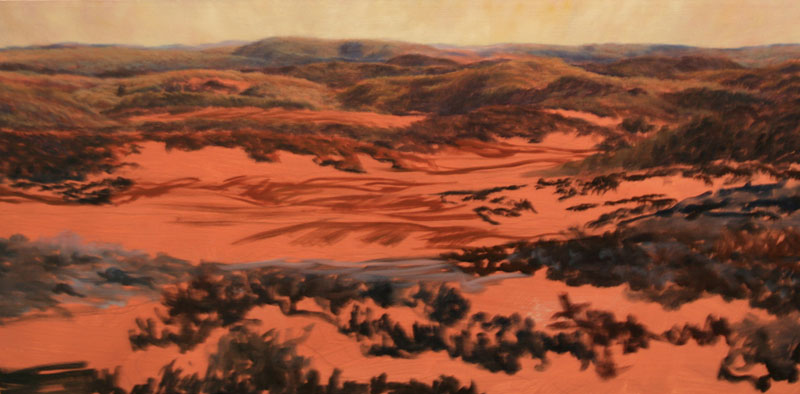
The 10th at Ballyneal in the early to mid stages.
This is the tenth at Ballyneal underway. It is derived from the best photo I took while visiting. I usually take some measurements, sketch it out in charcoal very loosely for a half hour or so and begin with the sky. I will work my way down the painting top to bottom, leaving filling in the bunkers until near the end of the process. I always need to go back and go over much of what I have done to adjust the strength of colors or contrast. Some things are painted wet on wet and others I allow to dry before moving ahead. That leaves the most difficult part, knowing when it is finished, and when to leave well enough alone. I always strive to keep evolving as a painter and most recently I have been pushing myself to show more texture.
7. What are some of the common mistakes that modern painters make in creating much of today’s bad golf paintings?
I don’t know, perhaps I am still making them. I guess just leaving that which is man made or anything that suggests it should be left out, fairway stripes, cartpaths etc. One thing I have learned from appreciating Mike Miller’s work is that as funny as it may sound, the less of the color green you use the better. He does that very well.
Being an assistant greenskeeper, you are accustomed to seeing a golf course at all times of the day. At what time of day do most courses look their best?
It will probably vary given the setting, however I usually prefer the afternoon light. It tends to show a warmer color spectrum which I love. Morning shots can also be nice especially for skies, but the presence of dew can really cool down the palette. Also, sometimes the best light occurs before mowing which can lead to blurred textures and less contrast.
One thing I have realized is that for the purpose of painting, I steer away from really overly dramatic shadows and super vibrant colors that often occur near dawn and dusk. I think those situations tend to distract us from viewing the brilliance of the terrain and architecture.
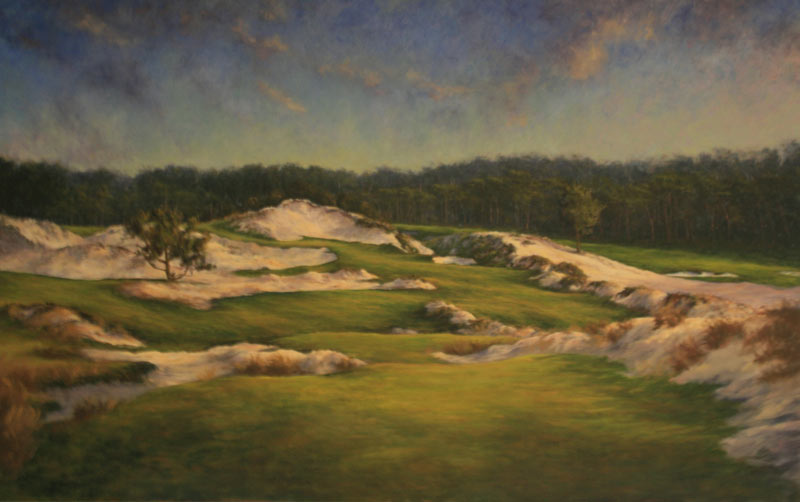
A work in progress – recent work of a near completed ninth at Cypress Point.
8. How have your tastes in golf courses evolved throughout the years?
First off, I have not been blessed to have golfed anywhere except for the US. But I think the easiest way to answer your question is, the older that I get, the more I like architecture that is ultra natural and breaks the commonly accepted ‘rules’. A few courses that I fell in love with after playing this year which meet that criteria are Kingsley Club, Ballyneal and Bandon Trails. Also, maintenance that goes away from the norm, for American standards at least, really impresses me. In my opinion luck should be an integral part of the game and in climates where it is possible, the ball should bounce and roll. A course should be judged first by the way the ball reacts rather than by the look and the color of the grass. It makes golf much more exciting. And if you had a really good chance of getting a horrible lie in a bunker, wouldn’t you take extra pains to make sure you avoided that bunker, and wouldn’t that really make you engage your strategic brain more.
I can remember loving playing golf and practicing short game in the dried out non irrigated courses on the Oregon Coast on summer trips. Practicing chipping when the ball bounds along the ground provides endless enjoyment for me.
9. What types of courses do you most yearn to paint?
Anything with imperfections and/or some history. I am really into golf landscapes that hold mother nature in high regard. Where the edges of the course are very blurred and the whole thing knits well with the landscape around. Stuff that breaks the standard, ‘this is what a golf hole should look like’, type of thing.
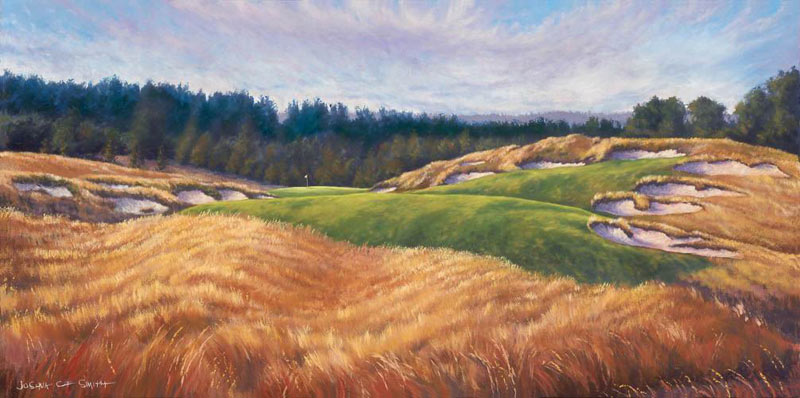
The sixth hole at the Kingsley Club.
10. How did visiting Pacific Dunes under construction influence you?
I am an Oregonian, but for the first three years of my life which were in Michigan, so naturally I couldn’t wait to see what was unfolding at Bandon. The first trip up, two of my friends and I drove up from San Francisco and met my brother who came down from Portland for a game at the newly opened Bandon Dunes. We intended to play 36 holes on the replay rate, but loved it so much, we forged on and played 54 the first day we were there. Blisters were such that I wore tennis shoes on the third 18. The eight hour ride home didn’t seem nearly as daunting given the recent excitement. I had a weekend off some year or so later and decided to make the drive to play Bandon Dunes again, alone.
A few months after that, I did the same thing and drove up alone again to soak in more of the resort. After arriving I put my things in my room at the lodge and went down for dinner and a glass of wine. I befriended a hostess and she told me I should meet her and some friends at a bar in Old Town Bandon after their Christmas party let out. A couple of hours later for the first and hopefully the last time, I was stood up. She didn’t show up, and going against my normally introverted personality, I decided I would stay at the bar and get a drink and try and strike up a conversation with someone. The first guys I approached looked about my age and I asked them ‘do you guys work at Bandon Dunes?’ They retorted, NO. At that point I was ready to walk out and bag this whole ‘be outgoing’ idea. Then one of the three guys said we are building a course next to Bandon Dunes. It turned out to be Brian Slawnick, a designer/shaper and on site guy for Tom Doak. His two buddies were Scots from Gleneagles who were helping with some of the native plantings. We turned out to have a lot in common and I was invited out the next day to wander around Pacific Dunes under construction.
This was kind of a life changing experience of sorts. Brian was explaining how the greens construction basically consisted of raking out the native sand to grades that worked. He explained that much of the creating was really just pushing up hills of sand and waiting to see how the wind erosion would have a shaping effect on the dunes. The idea that grass would grow on the native sand had somehow eluded me to this point. Pretty different from what I was used to seeing and supervising at Wadsworth. I was looking around at the bunkers and he explained they were pretty much ready to be seeded. Never having been over to Ireland or Scotland, I had never set foot on a site so rugged, natural and so made for golf. It kind of made me re evaluate what kind of golf courses I wanted to be a part of building.
I took plenty of photos and needless to say, Pacific Dunes was immediately the subject that I was most eager to paint. My first painting was the 11th hole, all sand, before it was seeded.
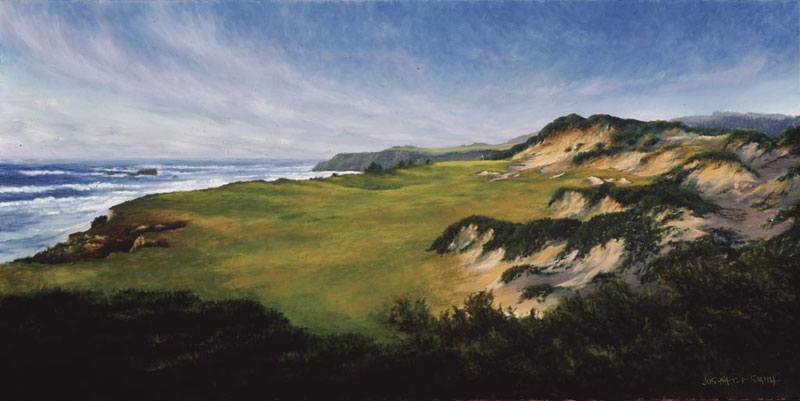
Every golfer takes delight in playing between the Pacific Ocean on the left and the huge dune on the right – no wonder the course is called Pacific Dunes!
11. Did anything else come from this relationship with Renaissance and Tom Doak?
Much has come from this relationship. I developed great respect for Tom and Jim Urbina and consider them both friends. Second, after meeting me, the San Francisco Golf Club asked me to try my hand at painting their course, which has been a dream scenario.
When it comes down to it, many of the breaks that have come my way have somehow been attributed to the snowball that came from that reply email from Tom Doak. After that stint at SFGC, I was committed to packing my things and driving out to Long Island, NY from California in order to work with Renaissance at Sebonack. Whether it was for the better or not, some insurance issues held my departure up, then the winter was closing fast. Right during that time, Pebble Beach Golf Links invited me to have some originals for sale in their Images of Pebble Beach gallery and I was having some sales success at SFGC. This was much earlier than I had dreamed it may happen. I was driving to Monterey about once a week. Shortly thereafter, Images of Pebble Beach sold an original for my highest figure yet and a few different framed reproductions for four figures. All that said, prices of my artwork, while increasing slowly, are still pretty low.
12. What five holes that you have played (two shotters) do you wish you could say you designed?
Pacific Dunes 9, Kingsley Club 6, Sand Hills 4, Pebble Beach 8, Cypress Point 9
13. What about the ninth at Pacific Dunes makes it among those you list?
I think it is the nondescript nature of the hole. It looks totally unplanned and just discovered. I mean the hole actually takes you on a journey. Having never been to Scotland or Ireland, I imagine many of those holes do the same. You are pretty much blind off the tee and hitting to a completely unlevel fairway. There is a large amount of anticipation teeing off and walking up to the rumbling fairway. As you get to the top, you realize just how wild the landing area is, to the right everything falls away, the center gathers left and left gathers left. As you approach the upper green the Pacific Ocean juts into view behind the green. I love the hole. But don’t ask me about the lower green, because in the 8 or 9 times I have played Pacific Dunes the flag has never been there. Which is actually very strange given they split it about 50/50.
14. Tell us about the 90-160y you designed (!) and built in someone’s backyard?
Two years ago I was asked to build a full length par three in an Orinda, CA homeowners backyard at a time when I was looking for part time work. It is a pretty severe carry over a deep ravine, the backdrop is aligned quite well with scenic Mt. Diablo. I convinced him to let me figure out the strategy and allow me to design/build it. My design fee was $35 an hour with nothing up front. I started by building a clay model. I think the project turned out well, but would love to hear you all pick it apart. This link, pasted to a URL will show an aerial photo of the design.
15. What was the story about your start at the Cal Club less than a year ago?
The Meadow Club restoration was over and I bought some time working on painting commissions that I had lined up for a few months. Mike DeVries had me paint two originals for him, and Mike Keiser had me paint something. I also had a couple of things to do for a SFGC member. Paul Daley was brainstorming a golf architecture book idea with heavy use of my paintings, but things were progressing slowly. After I finished those assignments, the rest of the painting opportunities immediately ahead of me were consignment deals. Actually, I did have a few more commissions upcoming, but they would have to wait until I visited those courses back east to begin anything. Relying on doing things on a consignment basis meant that if things were not selling right away, I wouldn’t have an income. Before I knew it I didn’t have an income. So I was getting pretty desperate, I looked for work online just to get something stable going. I wasn’t having much luck finding anything. I went down to Golfsmith and got a job. I remember having to cut a phone call short with you Ran, because it was time to punch in to work. As much as I wanted to keep chatting, it would not have been smooth to be 15 minutes late on my second day. There was something very wrong with that picture, and to make it worse, here I was playing a persimmon wood while trying to sell 500 dollar titanium to guys who came in. Three weeks later a Greenskeeper friend called me asking a favor, he asked me to call the California Golf Club Greenskeeper to put in a good word for him on another job opening. When I made the call to Thomas Bastis at Cal Club, he changed the subject to me and basically told me I was an idiot for working at a retail job with all of my golf construction experience. Implying I was going downhill. I appreciated his honesty. He told me he wanted me to come work for him as an assistant Greenskeeper and learn about the maintenance side of things. It made a lot of sense, especially because in less than a year, the club had a big improvements plan to carry out guided by Kyle Phillips. I had met Kyle and Mark Thawley (one of the first few discussion group posters) four years earlier and they were not only friends of mine but I respected greatly their work and ideas. It was a perfect match. During the project and afterward my experience would be very useful and they really liked the fact that I had some MacKenzie and Tillinghast restoration experience. California Golf Club was redesigned by Alister MacKenzie with Robert Hunter around 1927, since then some things have changed the classic character of the course. A few road encroachments cannot be remedied, but many other improvements can be made including unearthing much of the MacKenzie that has been neglected. All of the lakes will be removed and more than half of the cart paths as well.
The real irony of the hire was that one or two days before reporting to work for my first day, Kyle Phillips was on the phone with the GM suggesting that I do a painting of one of the proposed improvements to help convey his ideas before the membership voted. What’s so ironic is that Kyle had no idea that I was hired to work there yet. The painting needed to be framed just a week and a half after it was started, much quicker than I normally paint. I was back and forth daily over email with Kyle to get his critiques and changes. Needless to say, my first week of work was extremely busy, mornings learning the maintenance ropes and afternoon and evenings finishing the painting. I got to meet Aaron Oberholser and Ken Venturi at the dinner where my painting was displayed. After seeing the painting, Aaron said he would likely have me paint 18 at Pebble Beach for him, and that Jeff Brehaut another PGA touring pro who bought an original from me, had told him about my work when they had dinner month or so earlier.
I joke with Kyle and people around the club that the painting is the only reason the membership voted to go ahead with the project. Do I really believe that? No.
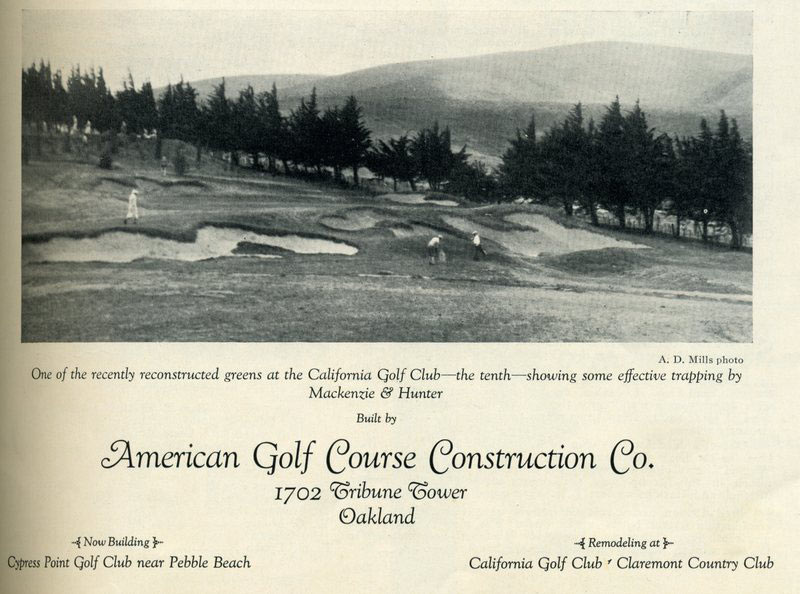
16. What types of golf imagery have captured your attention in forming your tastes?
British Golf Links has some black and white photos that are amazing. The sketches in Simpson and Wethered’s book have awesome feel and contrast. The color drawings from MacKenzie green details are unbelievable. Roundtree’s watercolors. Julian Graham’s black and whites and Geoff Shackelford today for bringing some greatly inspirational photos and books on stream. Cypress Point Club and The Golden Age books are tough to put down. I would love to see someone building a hole today match the before and after photos of the 9th hole at Cypress Point. Can you say restraint? I was blown away seeing Ken Bakst’s black and white photos in the Friars Head course profile four years ago. As crazy as it sounds I want to bring some of that black and white ‘feel’ into my color oil paintings. The old American Golf Course Construction Co. advertisements of MacKenzie’s work are amazing. Seeing the rough edged and rumpled courses that we are lucky to see erected today really holds my attention. You have to love the imperfections and natural appeal of courses from DeVries, Doak, B&B, Whitman and a small handful of others.
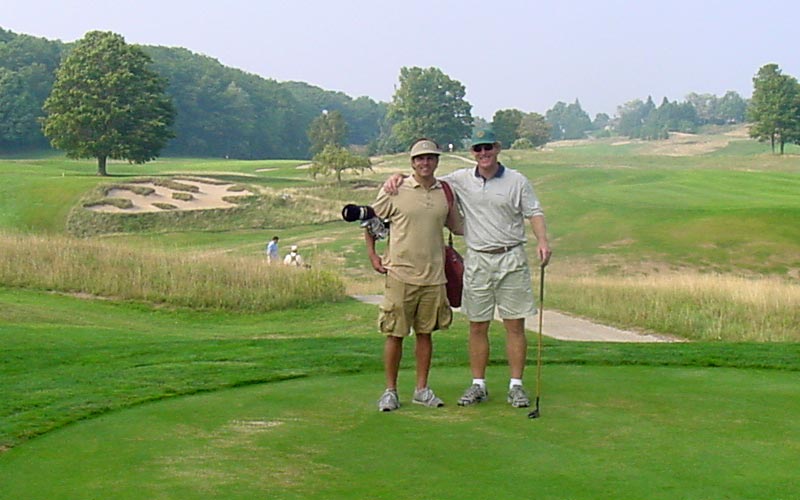
The artist, left, with Mike DeVries.
17. Why should someone commission you?
With my work as much as going after beauty, I try to focus on the architecture. I see the hazards and the strategy of the hazards as an big factor when choosing a perspective. Buying a painting is a really personal decision. I think it would come down to whether you really like the way I’ve portrayed a favorite golfing landscape. It reminds you of something you love about a setting or a hole. And in the case of a commission, you think I could faithfully represent a favorite scene on canvas judging from the potential of the subject and by my prior work. If there is a hole out there or scene that you love so much you want to see it honored on canvas, this might be a nice idea. The neat thing about a commission is the buyer is in part involved in the creation, and different than photography, the artist can choose the colors, textures, lighting, moods which might make it especially meaningful. Beyond that, as an oil painter I can actually paint something to portray an older look or rougher look if the particular course may currently be too clean looking. I guess some of that stuff can be done with photography now too, but call me a minimalist in this sense, I am pretty against photoshopping.
There are a handful of people doing some wonderful paintings now and quite a few have in the past, Mike Miller, Harry Roundtree, Arthur Weaver, and God rest his soul Mike Strantz was a pretty accomplished painter as well. I think you will notice real differences between all of us, and the beautiful thing about art is, everyone has their own tastes. I just hope to give each painting the real authentic feel that exists at each different course I paint. I am not really sure I want to be known to have a style, but want each painting to reflect the feeling that exists at that particular setting. Maybe this is similar to the best golf architects who choose to adapt to each site and follow mother natures lead rather than impose their style on a piece of property.
18. What are your future plans?
I hope to paint until I am old and gray. I hope that continued growth is in the cards. Being a golf course superintendent is the dual path that I want to continue on. I feel like I have a lot to offer in that area, from knowing how an ideal maintenance setup plays from some years playing at a high level, to years of construction experience, to a feel for aesthetics on a course how things should look natural. I am very happy to be at the California Golf Club as an assistant superintendent. We have already started the restoration/renovation/improvements project and I have been given the chance to assist in the shaping/bunker construction. What is really exciting about this construction project for me is that I don’t have to leave when it is over, I plan to stay for a number of years and am excited to be part of the grow in and watch it take life and mature into something really cool.
The End








